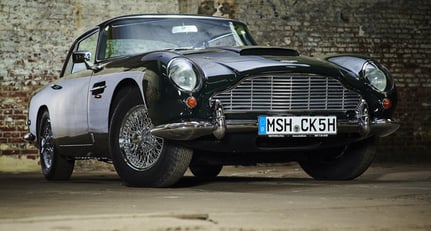1964 Aston Martin DB5
-
Year of manufacture1964
-
Chassis numberDB5/1430/R
-
Engine number400/1408
-
Lot number229
-
DriveLHD
-
ConditionUsed
-
Number of seats2
-
Location

-
Exterior colourOther
-
Drivetrain2wd
-
Fuel typePetrol
Description
1964 Aston Martin DB5 Sports Saloon
Registration no. German registered
Chassis no. DB5/1430/R
Engine no. 400/1408
'Like all classic GT cars, it combines enormous speed with comfort and the more you put into your driving, the more the car returns for your entertainment. And the DB5 really is entertaining to anyone who can exploit its outstanding performance, handling and brakes. It will also carry four people (just) and a fair amount of luggage so the merits of family transport (if need be) have not been entirely sacrificed to speed and elegant looks.' Motor.
Aston Martin's post-war evolution took a giant step forward with the launch of the DB4 in 1958. Classically proportioned, the Touring-designed body established an instantly recognisable look that would stand the marque in good stead until 1970. The engine was still an all-alloy, twin-overhead-camshaft, six but the old W O Bentley supervised 3.0-litre unit had been superseded by a new design by Tadek Marek. The new 3,670cc engine featured 'square' bore and stroke dimensions of 92mm, and developed its maximum power of 240bhp at 5,500rpm. The David Brown gearbox was a new four-speed all-synchromesh unit.
Touring's Superleggera body construction, which employed a lightweight tubular structure to support the aluminium-alloy body panels, was deemed incompatible with the DB2/4-type multi-tubular spaceframe, so engineer Harold Beach drew up an immensely strong platform type chassis. The DB2/4's trailing-link independent front suspension gave way to unequal-length wishbones while at the rear the DB4 sported a live axle located by a Watts linkage instead of its predecessor's Panhard rod.
Five series were built as the model gradually metamorphosed into the DB5. Introduced in July 1963, the Aston Martin DB5 boasted a 4.0-litre engine, this enlarged unit having been seen first in the Lagonda Rapide of 1961. Equipped with three SU carburettors, the '400' engine produced 282bhp at 5,500rpm and was mated to a four-speed/overdrive gearbox, a 'proper' ZF five-speed unit being standardised later.
The DB5's distinctive cowled headlamps had first appeared on the DB4GT and the newcomer was the same size as the lengthened, Series V DB4. Outwardly there was little to distinguish the DB5 from the last of the DB4s apart from twin fuel filler caps, though these had already appeared on some cars. Beneath the skin however, there were numerous improvements including alternator electrics, Girling disc brakes instead of Dunlops, Sundym glass, electric windows and an oil temperature gauge as standard equipment.
From September 1964 the 314bhp, triple-Weber Vantage engine became available and was fitted to a total of 95 cars. The DB5 was also offered in convertible form (the 'Volante' name would not be applied to the soft-top Aston until the DB6's arrival) while independent coachbuilder Harold Radford offered a shooting brake conversion. 1,021 DB5s were manufactured between July 1963 and September 1965, a total that included 123 convertibles and 12 shooting brakes.
The DB5 was the first and remains the most famous of all the 'James Bond' Aston Martins, having appeared in no fewer than five movies of the series, beginning with Goldfinger in 1964. Equipped with rocket launchers and sundry other gadgets, 007's DB5 was finished in Silver Birch with red interior, in which specification it was later issued by Corgi Toys.
The current vendor's Aston Martin ownership commenced with the purchase of an original left-hand drive DB Mark III while he was working as a surgeon in Cape Town, South Africa. When he returned home to Germany at the end of 1992, he took the Aston with him. In 1993 he met restorer Neil Smith, who offered a swap: the DB Mark III against a restored DB5 (the car offered here) with, of course, a corresponding premium. The restoration continued for quite some time thereafter and the owner did not take delivery of the DB5, which had been converted from right- to left-hand drive, until the summer of 1995. He and his new acquisition then undertook an extensive tour of England, Switzerland, Austria and Germany. After final finishing in England, the car was registered in Germany or the first time on 16th August 1996. Since then the owner has undertaken various tours through Germany with the DB5, which has always proved very reliable and is constantly admired by connoisseurs of motoring excellence. The car has always been kept and maintained (extensively) on a very high niveau (particularly the technical side) by the same car specialist (company. Mr Friedrich Rückert, specialist for classic cars for Aston Martin and Mercedes; sworn consultant). Something different would neither be acceptable for the owner nor for this specialist. Accompanying documentation consists of German TüV papers; a selection of photographs of an engine rebuild; and sundry restoration, a selection of maintenance and service invoices, the most recent of the latter dated 2014, as well as expertise by Classic Car Consultants, Düsseldorf dating February 2015, that has been translated into English. An Aston Martin DB5 instruction book is included in the sale.























